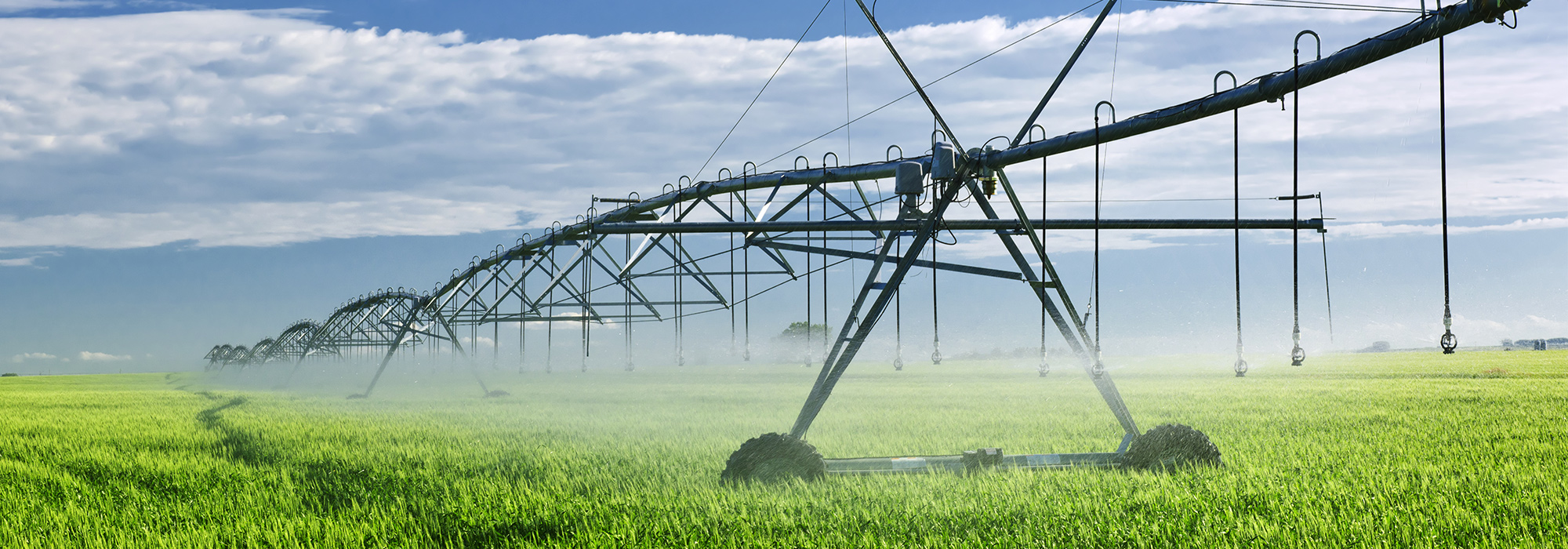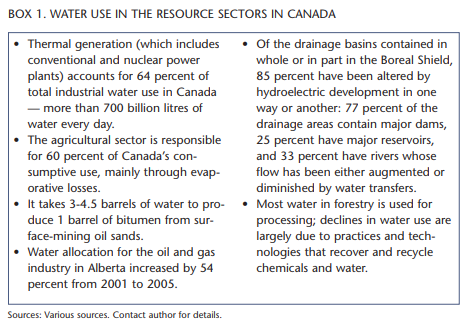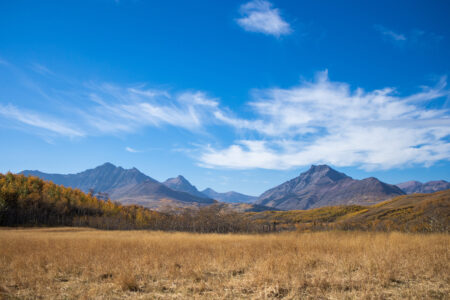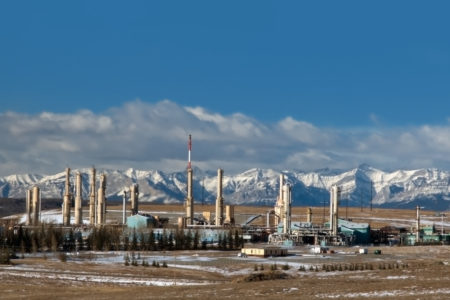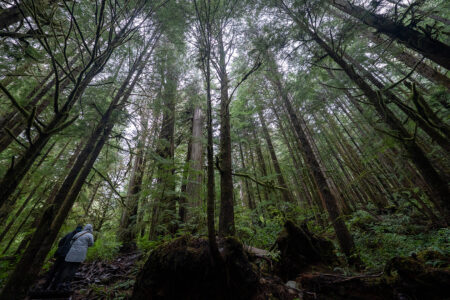
“Hewer of wood, drawer of water” has long been the dominant image of Canada’s economic historiography. We logged forests, mined valleys, tilled fields and drilled sediment — all to generate wealth and build a country. As we did so, we dammed rivers, diverted streams, dug wells and tapped aquifers, sustaining natural resource development decade after decade. Around us stood abundance, constrained only by the physical limits of labour and geography. And those seemed unlimited to a young, growing nation and a vast, horizonless vista.
Today that aphorism speaks to a new challenge and a different understanding. The long-running myth of Canada’s endless water resources is slowly being dispelled. The sustainability of our natural resource sectors is tied more and more to the sustainability of the most important natural resource of all: water. As demands increase worldwide for our energy and food, water use by industry will only grow. Without water to draw, we can hew no wood, mine no coal, drill no oil and farm no field.
Complicating this calculus is the threat of climate change. As temperatures rise, lake, river and aquifer levels may well diminish. Industries accustomed to widely accessible and often free water may be forced to use less of it or pay a greater price for it.
For all these reasons, the National Round Table on the Environment and the Economy (NRTEE) is undertaking a major new research program into the sustainability of water and Canada’s natural resource sectors. Examining the relationship between water and the resource sectors will lead to a clearer, deeper understanding of the policy issues and choices needed for the long-term sustainability of our water resource and how the forestry, mining, agricultural and energy sectors of our economy use it.
Canada’s water picture is a complex and even misleading one. The big portrait seems clear enough — it is one of plenty. Canada occupies 7 percent of the world’s land mass and possesses about 7 percent of its renewable fresh water. With over 2 million lakes scattered across the world’s second-largest country, approximately 8 percent of Canada’s surface is covered by fresh water. And yet, national estimates of lake volume, river and glacial runoff and groundwater are coarse if not absent.
That portrait is even less clear when it comes to water use by Canada’s natural resource sectors. The sectors’ importance to our economy is notable. They account for 16 percent of total GDP in 2007, according to Statistics Canada, and for about 50 percent of total exports; they directly employed nearly 1 million Canadians in 2008 according to Natural Resources Canada. In turn, they are far and away the largest user of water in the country, accounting for 22 percent of water consumption and 18 percent of pollutant releases to water. Box 1 summarizes the main facts about water use in these sectors.
Full knowledge of this interrelationship is not yet clear, because the science of climate change and water is variable and complex. We have some insight into areas that are expected to receive increased flooding or prolonged droughts. But the exact timing and duration of such events is unknown.
Overall, information on the volume and sources of water used by each of the natural resource sectors is incomplete and inconsistent despite the sectors’ dependence on water. In the absence of comprehensive data on the water embedded in our exports, we currently rely on water use estimates collected by Statistics Canada, and these rely on voluntary reporting. These estimates highlight that certain sectors depend on self-served water sources, meaning they draw from surface water or groundwater. Consistent ways of sampling and measuring are lacking. Significant changes in data collection methods present challenges to comparing water use over time. Gross water use has declined over the last decade, for example, but water consumption is rising.
There is growing recognition across Canada’s natural resource sectors about the need to consider water more directly in their business planning. However, the level of awareness of water-related risks varies greatly among and within sectors. Equally, there is variance in the character of water-related risks that currently or will in future affect each sector and region of the country. Some companies are critically aware of the physical risks affecting their profits, such as droughts that diminish agricultural yields and degrade soil quality. Others are more immediately concerned with reputational risks, such as the public outcry about the water used and discharged by oil sands industries. Still others are forced to face regulatory risks such as the reallocation of water permits or production limitations that result from policies limiting water use. Even initiatives to improve the environment in other ways, such as renewable fuel standards, have an impact on water. For instance, in the Green Paper prepared for the Alberta Institute of Agrologists (2007), Kurt Klein and Danny LeRoy estimate that producing one litre of ethanol requires between four and eight litres of water, depending on the process used.
To minimize these risks, efforts to improve or encourage water use efficiency are needed. Water efficiency offers a dual benefit by saving businesses money and energy; energy is saved because water use in most extraction, irrigation or production processes involves pumping and often water treatment. However, the net benefit of water efficiency is not always so cut and dried. For example, certain techniques, such as water recycling to lower water intake intensities, can also lead to intensified concentrations of pollutants that are discharged into the local ecosystem. All in all, it makes water and natural resources a complex sustainability relationship for industry, environmentalists, and governments alike.
Canada’s future use of its freshwater resources will be affected by both renewed economic growth and climate change.
Domestic production of natural resource-based goods is responsive to growing demands across the globe. As the global economy recovers, an increase in demand for our natural resource products both domestically and internationally can be anticipated. For example, according to the World Water Development Report 3 (2009), there will be a 60 percent rise in energy demand in 2030 compared to 2001. Producing that energy will require water. The need for more Canadian-produced food, driven in part by climate change impacts in other farming regions that will have become flooded or arid, can also be expected.
The 2008 Intergovernmental Panel on Climate Change (IPCC) technical paper on Climate Change and Water states, with “very high confidence,” that “climate change will constrain North America’s already over-allocated water resources, thereby increasing competition among agricultural, municipal industrial, and ecological uses.” Both the IPCC and the government of Canada acknowledge that climate change will have numerous and diverse effects on Canada’s water resources.
In the most general terms, Canadian winters are expected to be wetter and summers are expected to be drier. Regionally, the US Environmental Protection Agency Office of Water expects that climate change will raise winter temperatures, change the location and amount of rain and snow, increase storm intensity, change sea level rise and change ocean characteristics. Warmer temperatures will cause increased evaporation rates. This is expected to reduce the recharge of groundwater (water contained in soils and bedrock), although Canada lacks any definitive studies on the subject.
Full knowledge of this interrelationship is not yet clear, because the science of climate change and water is variable and complex. We have some insight into areas that are expected to receive increased flooding or prolonged droughts. But the exact timing and duration of such events is unknown. This does not diminish our need for preparedness and adaptation. We must gain a better understanding of the ecological impact of our natural resource sectors on water and its sustainability in an effort to improve our ability to adapt to climate change.
The leading climate change forecasts show that certain parts of Canada are likely to experience increasing mismatches between declining water supplies and increased water demand, depending on the vegetation, soil type, temperature and precipitation of the location). The likely impacts of climate change on Canadian water resources will include periods or events involving more widespread, more prolonged, more frequent and more extreme conditions of low water and high water affecting both surface and ground water, warns a recent Analysis of Canadian and Other Water Conservation Practices and Initiatives prepared by the Canadian Council of Ministers of the Environment (2006). In many of these affected basins, there will be direct and indirect impacts on the natural resource sectors, such as lower lake levels affecting hydroelectric production and shipping transportation; and increased erosion and forest fires, impacting agriculture and forest productivity. In fact, according to IPCC’s technical paper Climate Change and Water, climate change may already be affecting water levels and flow patterns in some areas, particularly in the West. But this information is not yet woven into the majority of resource expansion and water allocation decisions.
Not surprisingly, because Canada is a federation spread out across a very large land mass with shared federal-provincial/territorial jurisdiction, water management here has taken on many forms. While most of Canada’s water experts have been vocal about the need for federal leadership on water, it is broadly accepted that the actual “management” of water must occur in a local context.
Indeed, the provision of water — that is, the water that is in place at a given time to serve our needs — is an ever-changing ensemble of temperature, rain, wind and ground conditions. The ecosystem needs of one watershed cannot be directly compared with those of another. And yet the weakness of current regimes for water allocation and diversion — which exist under provincial and territorial jurisdiction — is largely attributed to the failure to address the need to effectively manage water sources across political boundaries. We have yet to devise an effective system that accounts for the interplay between land and water, resource use and municipal use, and local, regional, national and international policies.
Even the legal status of water differs across the country. For example, on June 12, the National Assembly of Quebec passed a bill affirming the collective nature of water resources in Quebec (water is owned by all citizens collectively). In most other provinces and territories water is deemed to be owned by the provincial Crown. Aboriginal land claims and resulting water rights are also important in this context. Regulating each sector individually, with varying water rules sometimes independent of the ecosystem needs, is an added complication.
In general, we do not know all we need to about the volume of water that exists, how quickly it recharges or the interplay between surface and ground water sources.
An important obstacle faced by governments and water managers is the lack of common data standards and architecture. Compounding this is an equal lack of basic information about the location of the water. In general, we do not know all we need to about the volume of water that exists, how quickly it recharges or the interplay between surface and ground water sources. Recognizing that “perfect information” may never exist, most regions in Canada have risen to the challenge of making progress to address the complexities of water management in a more adaptive, holistic manner. For example, a recent Policy Research Institute report noted that there are over 130 water stewardship organizations in Canada that are bridging the gaps between jurisdictional governance challenges, through integrated watershed management.
If Canada is to make headway in evolving its knowledge and decisions around groundwater and surface water use, surely this is the kind of flexibility that will continually need to be built into the system.
Recognizing the importance of this issue and the need for urgent action, the NRTEE brought together 45 leading water experts from across Canada in February 2009, to scope out a new national water sustainability program focused on Canada’s natural resource sectors. The Water and Canada’s Natural Resource Sectors Program aims to:
- identify the critical issues and opportunities associated with the water and natural resource sectors interrelationship; and
- catalyze the design and implementation of new policies, approaches and mechanisms through which water can be managed to foster both ecosystem health and economic sustainability of the sectors.
Consensus emerged on four key challenges that need to be addressed.
First, we need to improve the link between water science and policy. Before effective long-run adaptive planning can move forward, knowledge gaps must be addressed. No one sector knows exactly how much water is being used or will be available for future sector use. Some industries, including those in the four resource sectors, may have traditionally underestimated the severity and impact of alterations in water supply on their processes. Understanding these changes is essential for effective policies that are adaptive and based on scientific data rather than just estimates.
Furthermore, Canada’s water science expertise is diminishing. The need to reinvest in scientific knowledge base and rebuild the hydrologist capacity within government was repeatedly cited by experts.
Second, we need to build upon existing examples of integrated water governance structures. Water governance is a responsibility shared by numerous actors operating at different levels. It is complex and, in many cases, inefficient. Water allocation, permits, planning decisions and sector rules are largely disparate, lacking a common set of values, despite their interconnected nature. The policy framework must be adapted to incent enhanced conservation efficiency and water productivity. However, there is first a need to better understand the relative roles and potential for incentives and regulations in water management.
An opportunity exists to address this policy issue and explore tools that could stimulate greater production efficiencies and reduce risks associated with the changing landscape of water. Local governance structures that are innovative and inclusive, such as the Fraser Basin Council in British Columbia, merit consideration.
Third, ecosystem security must be incorporated in water allocation decisions. If aquatic ecosystems are to be supported, a greater understanding of the appropriate “allocation for ecosystems” is needed to inform water use decisions by others. But the complexity of understanding the requirements of ecosystems, related to in-stream flow needs for example, poses real challenges in making sustainable water management decisions. Increasingly, however, the need to consider the sustainability of the ecosystem may outweigh traditional water allocation policies for some watersheds.
Finally, production cost must incorporate the true value of water. For the most part, Canadian companies do not factor water’s economic or ecological value into their costs. With little or no financial “value” placed on water, this is not surprising. Provincial and territorial licensing fees account for less than 1 percent of total water costs paid by natural resource companies. We can learn from municipal use examples where a drop in water use occurs when consumers are charged based on consumption rather than a simple flat rate. Still, water metering across Canada as a comprehensive management tool is uneven and inadequately applied. Elsewhere in this issue, Steven Renzetti and Colin Busby examine these questions in greater details.
The paradigm of unlimited growth and abundance that has traditionally governed natural resource management, rather than sustainability, will need to change for this to happen. There is a need to shift to a system that is more reflective of ecological limits and the true value of ecological goods and services. Considering the full value of water in the natural resource sectors including pricing will likely have to be contemplated.
Water use challenges will only continue to increase as the demand for our natural resource products grows and international competition for water resources surges. Climate change may prove to have irreversible effects that will alter Canada’s own water resource capacity. The natural resource sectors are reliant on water. Canada, in turn, relies strongly on the economic value of natural resource sectors. Our interrelationship with water extends beyond our taps and tubs and into our economy. To succeed and remain competitive and to preserve and protect this most essential resource, water management must evolve into a practice of conservation, efficiency and adaptability where ecosystems are an asset worth protecting and water is truly valued as an investment for our future.
Photo: Shutterstock



